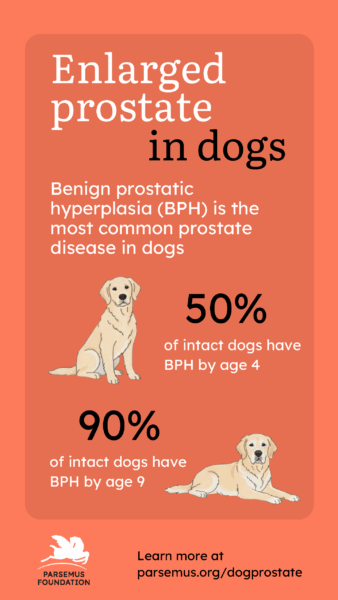Treating BPH without surgery
Most intact dogs develop an enlarged prostate, called benign prostatic hyperplasia (BPH), as they age. It’s the most common prostate disease in dogs. Castration is often the recommended treatment, but other options are available to preserve hormones and breeding ability. A recent publication in Veterinary Sciences reviewed medical treatments for enlarged prostate and their effect on reproductive potential. In addition, a nonpharmaceutical approach is available.
Causes of enlarged prostate in dogs
Humans and dogs share a common condition related to aging: the size of the prostate increases. In dogs, BPH is characterized by two types of prostate growth. As described in the review article on canine BPH, hypertrophy is an increase in prostate cell size, and it is usually induced by estrogen levels. Hyperplasia is an increase in prostate cell numbers which is the primary driver of prostate growth in dogs. It is caused by a metabolic shift over time in which testosterone is converted to DHT (dihydrotestosterone).

Changes over time in estrogen and testosterone metabolism are important for the development of BPH. That’s why BPH is much more common in intact dogs than in neutered dogs, because castration removes the organs that primarily produce sex hormones. However, a small percentage of neutered dogs also develop BPH.
When is BPH a problem for dogs?
Many dogs do not show signs of having an enlarged prostate. In others, they may develop blood in their urine, painful urination, constipation, and painful straining to relieve pressure from the prostate. Complications include prostatitis or inflammation of the prostate, cysts, hernias, and infertility.
The common treatment for BPH in intact dogs is neutering, because castration removes the organs that produce hormones related to BPH. However, castration is not a good choice for many dogs, including those used in breeding, competition, or hunting. Some working dogs may also lose their skills after castration.
Research has also shown that the loss of natural hormones from neutering can affect various body systems, particularly when the procedure is completed early in life. Joint disorders, cancers, immune disorders, obesity, and other issues are often more common in spayed and neutered dogs. While most dogs with BPH symptoms are older, owners may not want their pet to lose natural hormones. Thus, there’s great interest in treatments for enlarged prostate that are nonsurgical and don’t affect natural hormone levels.
Nonsurgical treatment options for canine BPH
Scientists from the University of Bucharest and Guelph University conducted a review of medical treatment options for canine BPH. The goal was to evaluate which treatments may be appropriate for breeding dogs. The researchers assessed 35 studies using various medications to treat BPH, focusing on the impact on prostate size, sperm quality, and hormone levels. Nine medications were evaluated.
Recommended medications
Finasteride and osaterone acetate were recommended for breeding dogs due to the limited impact on reproductive measures and studies showing safety and effectiveness. Appetite and weight gain were common side effects.
- Finasteride was the most studied medication. It’s a 5α-reductase inhibitor that doesn’t bind to the androgen receptor. Depending on the dose, finasteride reduces DHT levels, prostate size, and symptoms. Testosterone levels are usually unaffected, but impacts on sperm quality are not clear.
- Osaterone acetate is a steroidal antiandrogen that produces rapid improvement in BPH symptoms. Some research has indicated that it has a temporary effect on testosterone levels and sperm quality.
Medications not recommended
Treatment that was not recommended included tamoxifen and acyline because of the negative effects on reproduction. Tamoxifen is an antiestrogen and acyline is a GnRH agonist. Both are effective in treating BPH, but also directly affect hormones and the reproduction system.
Medications needing more research
Other medications have shown effectiveness for the treatment of BPH, but have not been studied enough to understand the full impact on reproductive measures or to make conclusive recommendations:
- Anastrazole, an aromatase inhibitor, reduces the conversion of androgens to estrogens
- Tadalafil is commonly used to treat erectile dysfunction and BPH in humans
- Mepartricin is an antibiotic used to treat BPH and prostatitis in humans
- Urtica fissa is a Chinese herb that has shown some promise in treating canine BPH
The authors note that much more research is needed to evaluate the safety and efficacy of these drugs in regard to fertility preservation.
Non-pharmaceutical treatment for canine BPH
There’s a method of treating canine BPH that does not rely on surgery or drugs. Pulsed electromagnetic field (PEMF) therapy is commonly used for many human conditions, such as enlarged prostate, osteoarthritis, bone repair, and even cancer.
A study on the use of PEMF for dogs with BPH, supported by the Parsemus Foundation, resulted in a successful reduction in prostate volume. Twenty dogs with enlarged prostates were treated with PEMF for 5 minutes, twice a day for three weeks. The device was simply held over the skin where the prostate is located. This resulted in a 50% reduction in the size of the prostate in just a few weeks, and the effect lasted for months.
This method of treating BPH can be used in all dogs, including breeding males and those that cannot undergo surgery. PEMF is known to be very safe, without side effects. For more information and details about the PEMF device used in the study, see our webpage on enlarged prostate in dogs.
See our other news articles on enlarged prostate.


